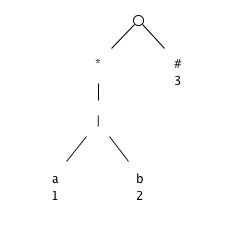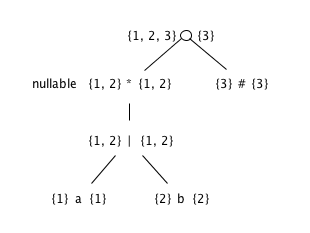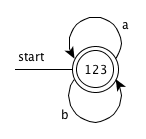Exercises for Section 3.9
3.9.1
Extend the table of Fig. 3.58 to include the operators
- ?
-
Answer
| node n | nullable(n) | firstpos(n) |
|---|---|---|
| n = c_1 ? | true | firstpos(c_1) |
| n = c_1 + | nullable(c_1) | firstpos(c_1) |
3.9.2
Use Algorithm 3.36 to convert the regular expressions of
Exercise 3.7.3 directly to deterministic finite automata.
Answer
-
(a|b)*
-
Syntax tree

-
firstpos and lastpos for nodes in the syntax tree

-
The function followpos
node n followpos(n) 1 {1, 2, 3} 2 {1, 2, 3} 3 ∅ -
Steps
The value of firstpos for the root of the tree is {1, 2, 3}, so this set is the start state of D. Call this set of states A. We compute Dtran[A, a] and Dtran[A, b]. Among the positions of A, 1 correspond to a, while 2 correspond to b. Thus Dtran[A, a] = followpos(1) = {1, 2, 3}, Dtran[A, b] = followpos(2) = {1, 2, 3}. Both the results are set A, so dose not have new state, end the computation.
-
DFA

-
-
(a*|b*)*
-
((ε|a)|b*)*
-
(a|b)*abb(a|b)*
3.9.3 !
We can prove that two regular expressions are equivalent by
showing that their minimum-state DFA’s are the same up to renaming of states.
Show in this way that the following regular expressions: (a|b)*, (a*|b*)*, and
((ε|a)b*)* are all equivalent. Note: You may have constructed the DFA’s for
these expressions in response to Exercise 3.7.3.
Answer
Refer to the answers of 3.7.3 and 3.9.2-1
3.9.4 !
Construct the minimum-state DFA’s for the following regular expressions:
- (a|b)*a(a|b)
- (a|b)*a(a|b)(a|b)
- (a|b)*a(a|b)(a|b)(a|b)
Do you see a pattern?
3.9.5 !!
To make formal the informal claim of Example 3.25, show
that any deterministic finite automaton for the regular expression
(a|b)*a(a|b)…(a|b)
where (a|b) appears n - 1 times at the end, must have at least 2n states. Hint:
Observe the pattern in Exercise 3.9.4. What condition regarding the history of
inputs does each state represent?
 正则表达式与DFA转换详解
正则表达式与DFA转换详解





 本文深入探讨了正则表达式的概念,并详细解释了如何使用算法将正则表达式直接转换为确定有限自动机(DFA)。通过具体实例,展示了不同正则表达式的语法树构建,firstpos与lastpos节点的计算,以及如何根据这些计算结果构建DFA。此外,还讨论了如何证明两个正则表达式的等价性,以及最小状态DFA的构造方法。
本文深入探讨了正则表达式的概念,并详细解释了如何使用算法将正则表达式直接转换为确定有限自动机(DFA)。通过具体实例,展示了不同正则表达式的语法树构建,firstpos与lastpos节点的计算,以及如何根据这些计算结果构建DFA。此外,还讨论了如何证明两个正则表达式的等价性,以及最小状态DFA的构造方法。
















 1万+
1万+

 被折叠的 条评论
为什么被折叠?
被折叠的 条评论
为什么被折叠?








